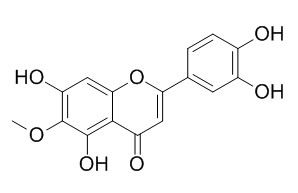6-Methoxyluteolin
6-Methoxyluteolin has antioxidant activity, it is a potent inhibitor of histamine release and calcium influx via down-regulation of the FcεRI α chain.
Inquire / Order:
manager@chemfaces.com
Technical Inquiries:
service@chemfaces.com
Tel:
+86-27-84237783
Fax:
+86-27-84254680
Address:
1 Building, No. 83, CheCheng Rd., Wuhan Economic and Technological Development Zone, Wuhan, Hubei 430056, PRC
Providing storage is as stated on the product vial and the vial is kept tightly sealed, the product can be stored for up to
24 months(2-8C).
Wherever possible, you should prepare and use solutions on the same day. However, if you need to make up stock solutions in advance, we recommend that you store the solution as aliquots in tightly sealed vials at -20C. Generally, these will be useable for up to two weeks. Before use, and prior to opening the vial we recommend that you allow your product to equilibrate to room temperature for at least 1 hour.
Need more advice on solubility, usage and handling? Please email to: service@chemfaces.com
The packaging of the product may have turned upside down during transportation, resulting in the natural compounds adhering to the neck or cap of the vial. take the vial out of its packaging and gently shake to let the compounds fall to the bottom of the vial. for liquid products, centrifuge at 200-500 RPM to gather the liquid at the bottom of the vial. try to avoid loss or contamination during handling.
Korean Herb. Med. Inf.2020, 8(2):233-242.
Mol Biol Rep.2022, doi: 10.1007
J Pharm Biomed Anal.2024, 251:116444.
Research on Crops.2017, 18(3):569
Nutrients.2024, 16(14):2267.
J Cosmet Dermatol.2022, 21(1):396-402.
Nat Prod Commun.2014, 9(5):679-82
Chem Biol Interact.2020, 328:109200.
J. Soc. Cosmet. Sci. Korea2021, 47(1):57-63
Appl Biochem Biotechnol.2020, 190(2):732-744
Related and Featured Products
3,5,6,7,8,4'-hexamethoxyflavone
Catalog No: CFN91805
CAS No: 34170-18-8
Price: Inquiry(manager@chemfaces.com)
3,3',4',5,6,7,8-heptamethoxyflavone
Catalog No: CFN95021
CAS No: 1178-24-1
Price: $268/10mg
4'-Hydroxyflavone
Catalog No: CFN91544
CAS No: 4143-63-9
Price: $30/20mg
4'-Methoxyflavone
Catalog No: CFN70361
CAS No: 4143-74-2
Price: Inquiry(manager@chemfaces.com)
7-Hydroxy-4'-methoxyflavone
Catalog No: CFN70378
CAS No: 487-24-1
Price: Inquiry(manager@chemfaces.com)
3',4'-Dihydroxyflavone
Catalog No: CFN70360
CAS No: 4143-64-0
Price: $60/20mg
3',4'-Dimethoxyflavone
Catalog No: CFN70359
CAS No: 4143-62-8
Price: $70/20mg
7,3',4'-Trihydroxyflavone
Catalog No: CFN97786
CAS No: 2150-11-0
Price: $118/20mg
3',4',7,8-Tetrahydroxyflavone
Catalog No: CFN70342
CAS No: 3440-24-2
Price: Inquiry(manager@chemfaces.com)
Luteolin
Catalog No: CFN98784
CAS No: 491-70-3
Price: $40/20mg
J Microbiol Biotechnol. 2012 May;22(5):622-7.
6-Methoxyluteolin from Chrysanthemum zawadskii var. latilobum suppresses histamine release and calcium influx via down-regulation of FcεRI α chain expression.[Pubmed:
22561855]
Mast cells and basophils are important effector cells in immunoglobulin-E (IgE)-mediated allergic reactions.
METHODS AND RESULTS:
Using the human basophilic KU812F cells, we assessed the inhibitory effects of 6-Methoxyluteolin, isolated from Chrysanthemum zawadskii, in the FcεRI-mediated allergic reaction. We determined that 6-Methoxyluteolin inhibited anti-FcεRI α chain antibody (CRA-1)-induced histamine release, as well as elevation of intracellular calcium concentration [Ca2+]i in a dose-dependent manner. Moreover, the inhibitory effects of 6-Methoxyluteolin on the cell surface expression and the mRNA level of the FcεRI α chain were determined by flow cytometric analysis and reverse transcription-polymerase chain reaction (RTPCR), respectively.
CONCLUSIONS:
Therefore, these results show that 6- methoxyluteolin is a potent inhibitor of histamine release and calcium influx via down-regulation of the FcεRI α chain.
Biomed Pharmacother . 2018 May;101:87-93.
Nepetin inhibits IL-1β induced inflammation via NF-κB and MAPKs signaling pathways in ARPE-19 cells[Pubmed:
29477475]
Abstract
Backgrounds: Chronic inflammation in retinal pigment epithelial (RPE) cells is related to the pathogenesis of retinal inflammatory blind causing diseases such as age-related macular degeneration (AMD) and diabetic retinopathy (DR). Nepetin, a natural flavonoid compound, has shown potent anti-inflammatory activities but has not been studied on ocular resident cells yet. Here, we assess the ability of Nepetin to alleviate the inflammatory responses of ARPE-19 cells induced by interleukin (IL)-1β.
Methods: The secretion and mRNA expression of inflammatory cytokines IL-6, IL-8 and monocyte chemoattractant protein-1 (MCP-1) induced by IL-1β are measured by enzyme-linked immunosorbent assay (ELISA) and real-time polymerase chain reaction (RT-PCR) respectively. To clarify the underlying action mechanism, we examine the effect of Nepetin on activation of nuclear factor of kappa B (NF-κB) and mitogen-activated protein kinase (MAPK) signaling pathways using Western blot.
Results: Nepetin can significantly decrease the three inflammatory mediators at both protein and mRNA level in a dose-dependent manner. Western blot results show that Nepetin can decrease the nuclear translocation of p65 through suppressing phosphorylation of inhibitor of nuclear factor kappa B (IκB) and IκB kinase (IKK). Also, Nepetin can decrease the phosphorylation of extracellular signal-regulated kinases (ERK) 1/2, c-Jun N-terminal kinase (JNK) and p38 MAPK.
Conclusions: Taken together, Nepetin abolishes IL-1β-induced IL-6, IL-8 and MCP-1 secretion and mRNA expression by repressing the activation of NF-κB and MAPKs. These results indicate that Nepetin shows potential to be used for prevention and treatment of inflammatory retinal diseases or as a lead compound.
Keywords: ARPE-19; Inflammation; MAPK; NF-κB; Nepetin.



